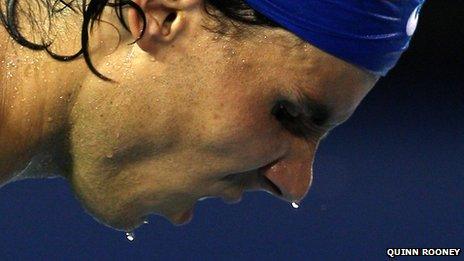What happens to the body in extreme heat?
- Published

The dangers of playing football matches in 40-50C temperatures could mean that the 2022 World Cup in Qatar takes place in the cooler, winter months.
Meanwhile, parts of England have seen six consecutive days of temperatures above 30C, prompting official health alerts.
So what is the body's key way of dealing with the heat?
When temperatures rise, the body reacts by increasing blood flow to the skin's surface, taking the heat from within the body to the surface.
This means sweat.
As the sweat evaporates, the body cools down.
If, as in the UK, our skin temperature is warmer than the external temperature we are also able to lose heat to the environment, termed 'dry heat loss'.
But in hot, dry climates - like Qatar - this would not happen.
The body would be completely dependent on sweat.
Dependent on sweat
The body's normal core temperature is 37-38C.
If it heats up to 39-40C, the brain tells the muscles to slow down and fatigue sets in.
At 40-41C, heat exhaustion is likely - and above 41C, the body starts to shut down.
Chemical processes start to be affected, the cells inside the body deteriorate and there is a risk of multiple organ failure.
The body cannot even sweat at this point because blood flow to the skin stops, making it feel cold and clammy.
Heatstroke - which can occur at any temperature over 40C - requires professional medical help and, if not treated immediately, chances of survival can be slim.
The best method of cooling people down is to immerse them in ice water or apply ice packs to the groin and armpits where crucial arteries are located - but it all depends on how long the body has been at an elevated temperature.
George Havenith, professor of environmental physiology and ergonomics from Loughborough University, says humidity - the amount of moisture in the air - is critical in determining how much we can sweat out.
If humidity is high, our ability to sweat is impaired and this makes us feel awful.
But if it is hot and dry - like Qatar - sweat can help.
"We can evaporate a lot of moisture from our skins - but we also have to produce it," says Prof Havenith.
"This means going to very high sweat rates quickly, and people might be limited by the amount of sweat they can produce."
So someone running at around 15km per hour in temperatures up to 37C would need to produce four litres of sweat per hour.
Heating up
Jamie Pringle, an exercise physiologist, works with professional triathletes at the English Institute of Sport in Sheffield.
He says the fitter athletes are, the better they are able to cope with heat - and Tour de France leader Chris Froome is a good example.
"Training increases blood volume in the body and that's where you sweat from so someone like Froome will have 10-12 litres of blood in his body compared to six litres in the average male."
A serious athlete is going to build up high blood volume and can therefore sweat more and cool down more quickly and effectively when the going gets hot.
Pringle says we can all improve our ability to hold on to fluids by spending a week or two in a heat chamber and exercising on a treadmill.
The key is to listen to your body, Prof Havenith says.
"Most amateur runners naturally slow down when they get too hot, but there are always people who keeping pushing themselves further and that's when things go wrong."
- Published17 July 2013
- Published20 August 2012